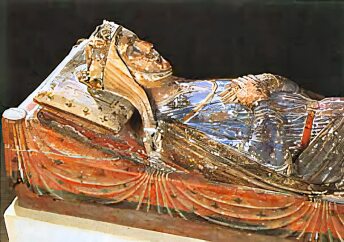Richard I "the Fearless" or (French) "Sans Peur"
 |
| Richard the Fearless as part of the Six Dukes of Normandy statue in the town square of Falaise |
Richard I of Normandy (933–996), also known as Richard the Fearless (French: Sans Peur), was the Duke of Normandy from 942 to 996. Dudo of Saint-Quentin, whom Richard commissioned to write his De moribus et actis primorum Normanniae ducum (Latin: On the Customs and Deeds of the First Dukes of Normandy), called him a dux, but this use of the word may have been in the context of Richard's leadership in war, and not a reference to a title of nobility.Richard either introduced feudalism into Normandy, or he greatly expanded it. By the end of his reign, most important landholders held their lands in feudal tenure.
Birth
Richard was born to William I of Normandy, princeps or ruler of Normandy, and Sprota. He was also the grandson of the famous Rollo. He was about 10 years old when his father was killed on 17 December 942. His mother was a Breton concubine captured in war and bound to William by a Danish marriage. William was told of the birth of a son after the battle with Riouf and other Viking rebels, but his existence was kept secret until a few years later when William Longsword first met his son Richard. After kissing the boy and declaring him his heir, William sent Richard to be raised in Bayeux. After William was killed, Sprota became the wife of Esperleng, a wealthy miller; Rodulf of Ivry was their son and Richard's half-brother.
Life
When his father died, Louis IV of France seized Normandy, installed the boy Richard in his father's office, then placed him in the care of the count of Ponthieu. The king then split the lands, giving lands in lower Normandy to Hugh the Great. Louis kept Richard in confinement at Lâon, but he escaped with the assistance of Osmond de Centville, Bernard de Senlis (who had been a companion of Rollo of Normandy), Ivo de Bellèsme, and Bernard the Dane (ancestor of families of Harcourt and Beaumont).
In 946, Richard agreed to "commend" himself to Hugh, Count of Paris. He then allied himself with the Norman and Viking leaders, drove Louis out of Rouen, and took back Normandy by 947.
In 962 Theobald I, Count of Blois, attacked Rouen, Richard’s stronghold, but his army was defeated by the Normans and retreated never having crossed the Seine. Lothair king of the West Franks stepped in to prevent any further war between the two.
Afterwards, and until his death in 996, Richard concentrated on Normandy itself, and participated less in Frankish politics and petty wars. In lieu of building up the Norman Empire by expansion, he stabilized the realm, and united his followers into a cohesive and formidable principality.
Richard used marriage to build strong alliances . His marriage to Emma connected him to the Capet family. His wife Gunnor, from a rival Viking group in the Cotentin, formed an alliance to that group, while her sisters form the core group that was to provide loyal followers to him and his successors. His daughters provided valuable marriage alliances with powerful neighboring counts as well as to the king of England.
He also built on his relationship with the church, restoring their lands and insured the great monasteries flourished. His reign was marked by an extended period of peace and tranquility.
Marriages
His first marriage (960) was to Emma, daughter of Hugh "The Great" of France, and Hedwig von Sachsen. They were betrothed when both were very young. She died after 19 March 968, with no issue.
According to Robert of Torigni, not long after Emma's death, Duke Richard went out hunting and stopped at the house of a local forester. He became enamoured of the forester's wife, Seinfreda, but she being a virtuous woman, suggested he court her unmarried sister, Gunnor, instead. Gunnor became his mistress, and her family rose to prominence. Her brother, Herefast de Crepon, may have been involved in a controversial heresy trial. Gunnor was, like Richard, of Viking descent, being a Dane by blood. Richard finally married her to legitimize their children:
 |
| Gonnor, wife of Richard I, confirming a charter of the abbey of the Mount-Saint-Michel, from archive of the abbey |
(c. 950–c. 1031), Duchess of Normandy, she was the (2nd) wife of Richard I of Normandy.
All that is known of Gunnora's parentage is that she belonged to a family who had settled in the Pays de Caux. Robert of Torigni wrote she was a forester's daughter from the Pays de Caux and according to Dudo of Saint-Quentin she was of noble Danish origin. Gunnora was probably born c. 950. Her family held sway in western Normandy and Gunnora herself was said to be very wealthy. Her marriage to Richard I was of great political importance, both to her husband and her progeny. Her brother, Herfast de Crepon, was progenitor of a great Norman family. Her sisters and nieces married some of the most important nobles in Normandy.
Robert of Torigni recounts a story of how Richard met Gunnora. She was living with her sister Seinfreda, the wife of a local forester, when Richard, hunting nearby, heard of the beauty of the forester's wife. He is said to have ordered Seinfreda to come to his bed, but the lady substituted her unmarried sister, Gunnora. Richard, it is said, was pleased that by this subterfuge he had been saved from committing adultery and together they had three sons and three daughters. Unlike other territorial rulers, the Normans recognized marriage by cohabitation or more danico. But when Richard was prevented from nominating their son Robert to be Archbishop of Rouen, the two were married, "according to the Christian custom", making their children legitimate in the eyes of the church.
Gunnora attested ducal charters up into the 1020s, was skilled in languages and was said to have had an excellent memory. She was one of the most important sources of information on Norman history for Dudo of St. Quentin. As Richard's widow she is mentioned accompanying her sons on numerous occasions. That her husband depended on her is shown in the couple's charters where she is variously regent of Normandy, a mediator and judge, and in the typical roll of a medieval aristocratic mother, an arbitrator between her husband and their oldest son Richard II.
Gunnora was a founder and supporter of Coutances Cathedral and laid its first stone. In one of her own charters after Richard's death she gave two alods to the abbey of Mont Saint-Michel, namely Britavilla and Domjean, given her by her husband in dower, which she gave for the soul of her husband, and the weal of her own soul and that of her sons "count Richard, archbishop Robert, and others..." She also attested a charter, c. 1024–26, to that same abbey by her son, Richard II, shown as Gonnor matris comitis (mother of the count). Gunnora, both as wife and countess, was able to use her influence to see her kin favored, and several of the most prominent Anglo-Norman families on both sides of the English Channel are descended from her, her sisters and nieces. Gunnora died c. 1031.
Richard & Gunnora's children
- Richard II "the Good", Duke of Normandy
- Robert, Archbishop of Rouen, Count of Evreux
- Mauger, Earl of Corbeil
- Emma of Normandy, wife of two kings of England
- Maud of Normandy, wife of Odo II of Blois, Count of Blois, Champagne and Chartres
- Hawise of Normandy m. Geoffrey I, Duke of Brittany
- Papia of Normandy
- William, Count of Eu
Richard was known to have had several other mistresses and produced children with many of them.
Known children are:
- Geoffrey, Count of Eu
- William, Count of Eu (ca. 972-26 January 1057/58),m. Lasceline de Turqueville (d. 26 January 1057/58).
- Beatrice of Normandy, Abbess of Montvilliers d.1034 m. Ebles of Turenne (d.1030 (divorced)
- Muriella, married Tancred de Hauteville
- Fressenda or Fredesenda (ca. 995-ca. 1057), second wife of Tancred de Hauteville.
Richard died in Fecamp, France, on 20 November 996.
Depictions in Fiction
The Little Duke, a Victorian Juvenile novel by Charlotte Mary Yonge: is a fictionalized account of Richard's boyhood and early struggles.
(source: Wikipedia)






























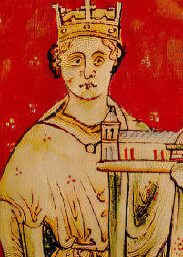 When John, the last child of the great
When John, the last child of the great  John incurred further opposition through his infatuation with
John incurred further opposition through his infatuation with 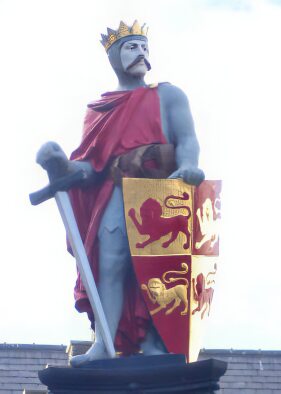
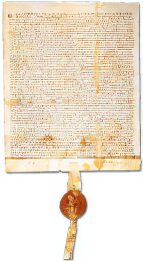 The King turned his attention to administration and justice in England, having inherited some of his famous father's administrative ability and restless energy. Pope Innocent III was annoyed at John's interference in the election of an Archbishop of Canterbury in 1205, a quarrel ensued, resulting in England being placed under an interdict, no church services could be held for six years. In 1209, the difficult John himself was excommunicated. The English barons were entering into plots against him, and John wisely made peace with the Pope. In May, 1213 he agreed to hold England as a fief of the papacy.
The King turned his attention to administration and justice in England, having inherited some of his famous father's administrative ability and restless energy. Pope Innocent III was annoyed at John's interference in the election of an Archbishop of Canterbury in 1205, a quarrel ensued, resulting in England being placed under an interdict, no church services could be held for six years. In 1209, the difficult John himself was excommunicated. The English barons were entering into plots against him, and John wisely made peace with the Pope. In May, 1213 he agreed to hold England as a fief of the papacy.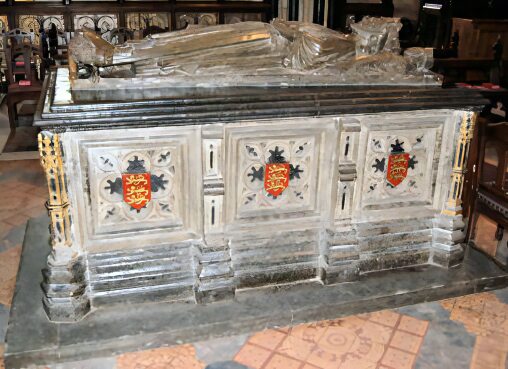 Faced with an armed revolt which may have cost him his kingdom, the king was forced into compliance. At Runnymede, near Windsor, on 15th June 1215, he signed the historic Magna Carta or Great Charter. The Charter curtailed royal power in matters of taxation, justice, religion and foreign policy.
Faced with an armed revolt which may have cost him his kingdom, the king was forced into compliance. At Runnymede, near Windsor, on 15th June 1215, he signed the historic Magna Carta or Great Charter. The Charter curtailed royal power in matters of taxation, justice, religion and foreign policy.